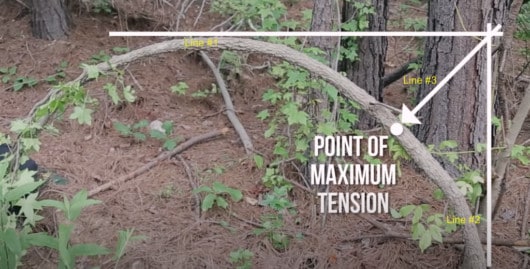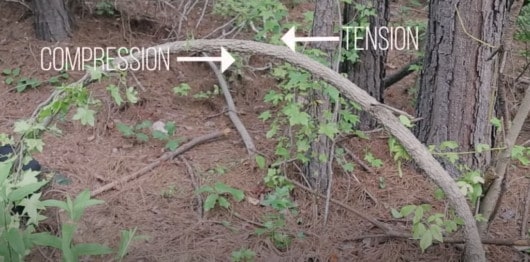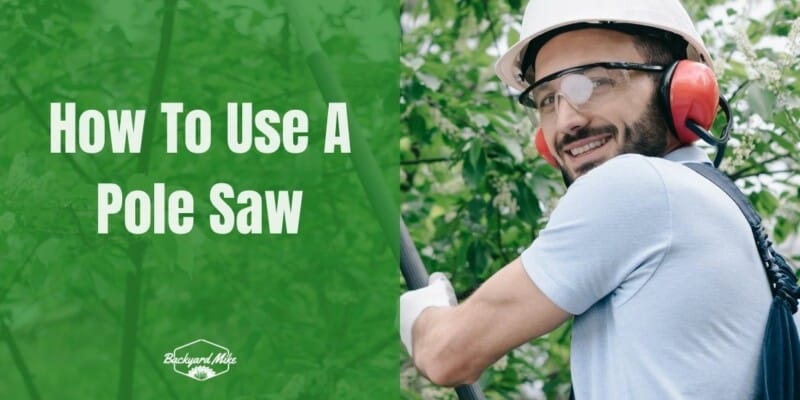Tree pruning can be a troublesome task, especially if you need to cut branches or tree limbs located high above the ground.
Although it’s a fairly straightforward job, standing on a ladder isn’t the only thing. There’s a difference between cutting tree branches and cutting tree branches the RIGHT WAY.
Don’t know how to use a pole saw? Then today’s your lucky day because I will be showing you how to use a pole saw and start cutting the PROPER and SAFE way.
Clear Your Work Area
Clearing your area may seem like common sense, but let me give you TWO reasons to explain how important it is:
Prevents Damage to Property and People
Branches fall RANDOMLY. You can’t just tie a rope to your branch (unlike when cutting whole trees) so that you can control where the branch falls like some pulley system.
You can’t fight Mother Nature!
If you do, then you’d have to climb up a ladder and tie the limb or branch. That just defeats the purpose of using pole saws altogether.
RELATED: Review of the Best Pole Saws – Top Picks to Perfect Your Landscape
Unless you know how to use a pole saw with rope WITHOUT climbing a ladder, then you are one heck of an innovator.
Avoid Possible Injuries to Yourself
Two words: TRIP HAZARDS. This is very serious. You’ll need to be on your toes and be aware of randomly falling branches.
With this, you want your focus to be on BRANCHES, not trip hazards. Think of it this way:
You see a branch falling on you, so you dodge it.
But you didn’t know your feet are tangled up in the power line of your pole saw, so you trip, and injure yourself while on duty.
You wouldn’t want that, would you? So clear out everything and everyone:
- Make sure your power source and line are out of the way. The same goes for all trip hazards like a garden hose, garden tools, chains, EVERYTHING.
- Also, make sure that EVERYONE is out of the area. If you’re in a public space, close off the area with tape, like the ones you see the cops use.
Plan Your Cut
You know the saying, “Failing to plan is planning to fail”?
Planning your cutting process is essential to pruning your tree well. You have to decide which tree branches to cut.
You don’t want to start cutting and regret it after the deed was done.
Deciding which branches and limbs to cut is almost entirely up to you, but there are a few rules of thumb that may tell you where to start cutting first.
Cut Lower Limbs and Branches First
We can go back to our first step in order to explain why we have to cut the lower limbs and branches first – CLEAR YOUR AREA.
Cutting the lower limbs and branches first basically means that we are clearing the area to have a safe environment to cut the upper limbs branches.
Cut Longer Limbs and Branches by Parts
Dealing with a long limb or branch can be such a hassle.
It’s even harder to predict how they’ll fall, so you should perform a few preliminary cuts and a jump cut first.
This reduces any chances of harm because of the unpredictability and weight of long tree branches.
Fix your Positioning
You’ve cleared the area, planned ahead, so can you cut now? NO. Not yet at least. We’re almost there, don’t worry.
Positioning is key in order to use a pole saw safely. There are a few things you have to position before you can actually cut.
Positioning Yourself
Basically, what you want to do is stand by the side of the tree. AVOID being directly underneath the tree branch, for obvious reasons.
Pole Saw Positioning
If your pole saw is adjustable, now is the time to adjust the length of the pole. The ideal length is from the branch you’re pruning up to your chest level.
Now, let’s proceed to the pole saw itself.
- Hold the end of the pole at chest level, making sure you have a nice grip on the handle.
- Move the pole saw towards the branch you want to cut.
- Take a moment to stabilize your grip on the pole saw. The chainsaw is quite heavy and hard to keep steady.
- Once you’re ready, rest a little bit of your weight onto the branch.
Cut
FINALLY! We are now ready to cut.
Remember your plan? Make sure to follow it, but don’t be afraid to make adjustments.
- Start slow and cut at the right angle with respect to your branch.
- Create a groove first by making a shallow cut.
- Proceed to cutting all the way through. The groove will guide you as you use a pole saw.
- Don’t hesitate to stop cutting if your pole saw is slipping uncontrollably. Reposition the pole saw, then you can proceed.
Clear Your Work Area Again
Why do you have to clean up again? Well, we made a mess. A piece of wood fell, and we don’t want to be tripping on it, don’t we?
Always remember to clear up your backyard whenever branches fall to the ground. This applies even for preliminary cuts for longer branches.
Rinse and Repeat
You’ve managed to cut the branch, so what’s next? Do it AGAIN. And AGAIN. And AGAIN. Basically, just stick to the plan and the steps above. Make sure to clean up afterward!
Pole Saw Safety Tips
Now that you know how to use a pole saw, is there anything else we should know about? Oh yeah, that’s right. SAFETY.
You wouldn’t want to lose a finger, right?
Using a pole saw requires you to take many precautions. Make sure to understand all the warnings and cautions that I’m about to discuss.
You can also read the pole saw manufacturer’s user manual for any extra precautions you can take.
Wear Protective Gear
Wear the proper personal protective equipment (PPE) when handling a pole saw, or any kind of chainsaw for that matter. These include but are not limited to:
- Goggles – Small falling debris are prone to getting in your EYE. Trust me, you wouldn’t want to lose an eye.
- Hard Hat – Heavy branches might potentially give you a CONCUSSION.
- Earplugs – You don’t want to be DEAF because of a chainsaw, right?
- Gloves – These aren’t just for the removal of sharp pieces of tree bark, gloves are also for better GRIP and handling of a pole saw.
- Steel Toe Boots – So that you don’t lose your TOES.
You can also buy a safety harness. The harness should fit well on top of your clothes and should clip onto your pole saw.
The harness spreads the weight of the saw throughout your whole body, reducing the strain on your body. That way, you don’t tire out and can last longer while using a pole saw.
Check the Weather
Use your pole saw ONLY when the weather is clear and dry.
It’s important to only cut when the weather is clear and sunny, so you SEE all the wood. Trees, branches, and all parts of the tree you’re about to cut.
It also goes without saying, you should NOT use a pole saw at night because of the reduced visibility.
You also shouldn’t cut when it’s wet, especially if you have an electric pole saw. You are ENDANGERING yourself by making yourself prone to ELECTROCUTION.
If you’re using manual pole saws, then you still shouldn’t cut in the rain. Pruning in the rain can still be dangerous due to the reduced visibility.
If you have experience on how to use a manual pole saw, then you would know that pruning in wet conditions will most likely make your saw RUST faster.
Cut One Branch at a Time
Safety precautions would tell us that we have to cut one branch or limb at a time.
Cutting more than one branch in one pass will leave you with more branches than you could handle. Your grip on the pole saw will most likely also slip.
Work on the tree one cut at a time. The job WILL get done, be patient.
Be Careful of Kickback
Kickback occurs when the saw blade of an electric-powered pole saw hits a particularly hard piece of tree or any other kind of material. It can also occur when the chain of the pole saw gets pinched by the tree.
So, how do you prevent kickbacks and its possible injuries?
Well, aside from the safety measures I already mentioned, you can do the following:
- Make sure you have a good grip on the pole saw.
- Ensure proper footing and weight distribution for stability
- ALWAYS know where the tip of the saw blade is
- Do NOT let the chain and saw blade touch the ground and hard pieces of wood while running
- Run your pole saw at FULL POWER when you feel the tree is about to pinch your pole saw
Always think of the direction of the moving chain of your pole saw. You can then anticipate if the saw will either RECOIL or launch you FORWARD.
Be Careful of Wood Under Tension
Branches that are in tension should be cut carefully. These branches may spring back in ways that are unpredictable.
Can you still use a pole saw in this case? Yes! You just have to use it differently.
First, locate where the branch is in most tension.
- Draw an imaginary line #1 at the peak of the curve created by the branch.
- Draw an imaginary line #2 upwards from at the base of the branch connected to the trunk
- At the intersection of the two lines, draw an imaginary line #3 at a 45-degree angle towards the branch.
- The point where line #3 and the branch intersects is the point of maximum tension.

Always cut at the side where compression occurs.
- Underside for inverted-U branches
- Top side for U-shaped branches

There are 2 ways to cut the branch:
- Make a series of small cuts on called accordion cuts
- Shave off a part of the branch
Do this until tension is released. You can then proceed to cut through with your pole saw. If you need more visual aid, this video will help.
Make Sure to Oil Your Chain
This makes your pole saw run smoother. With an oiled chain, you avoid instances of pinching when cutting through a tough branch.
Keeping the chain oil cap filled is a great way to ensure there is enough oil on your chain. This way, you can keep pressing on your chain oil bulb every 10 seconds for a well-oiled machine.
When to Call a Professional
I get it. You REALLY need to cut some trees. However, there are certain situations that require the help of a professional.
- Trees near a power line
- Trees with thick branches of more than 8 inches
Don’t try to prune these trees yourself. And remember, when in doubt, just call a professional.
Types of Pole Saws
What is a pole saw exactly? Aren’t there different kinds?
Well, there are a few, and hopefully, this knowledge helps you how to use a pole chain saw and its different types.
Cordless Pole Saws
A cordless pole saw is just basically a pole saw that runs on battery. Its main advantage is that you don’t have to worry about tripping on cords.
Although you still have to worry about that random vine that may have fallen.
Gas-Powered Pole Saws
As the name implies, gas-powered pole saws run on gasoline. This pole saw is one of the best power tools, but it is hard to maintain.
Maybe a little bit of an overkill for brush clearing and cutting up a vine, but definitely is perfect for large trees.
Electric Pole Saws
Electric pole saws have a cord built-in so that you can attach it to an electric power source. They are very light and are easy to maintain.
Just be careful of that cord, as you can SERIOUSLY injure people.
ALSO READ: Review of the Best Electric Pole Saws – Top Rated Corded and Cordless Pole Saws
Manual Pole Saws
Good old human power. Manual pole saws are basically hand saws with sticks on them.
There is no chain of any sort, and it takes a TON of work to cut. Unless you’re working on a thin vine.
Unlike your other kinds of pole saw, you can’t adjust the stroke speed nor hold the throttle lockout.
There are no controls for this saw, and your hand is your control. The Houston to your NASA.
Safety-wise though, this saw is the BEST. No doubt about it.
ALSO READ: Review of the Best Manual Pole Saws – For Home Use and Professionals
Hydraulic Pole Saws
Primarily only used by professionals, these saws are for the heaviest-of-duties only. Don’t go near them unless you are actually a professional.
Final Thoughts
Now that you got through the end of this how-to-use-pole-saw-guide, I hope that you actually learned how to use a pole saw, especially the safety part.
If someone shares a false safety tip, or any other wrong information regarding the use of a pole saw, make sure to let them hear it! Enjoy cutting!


